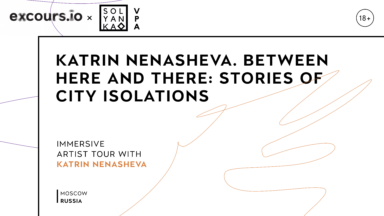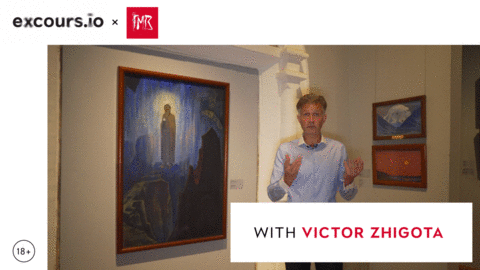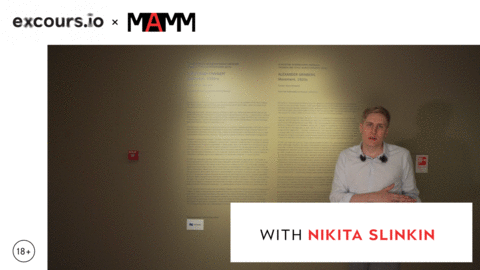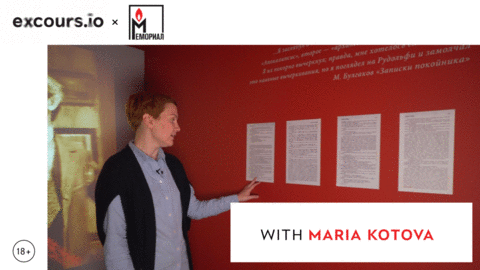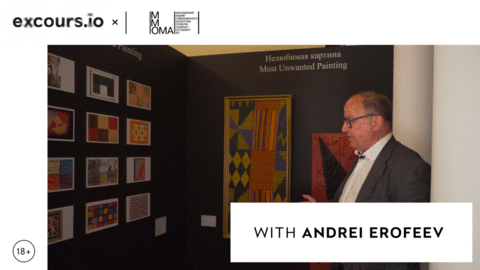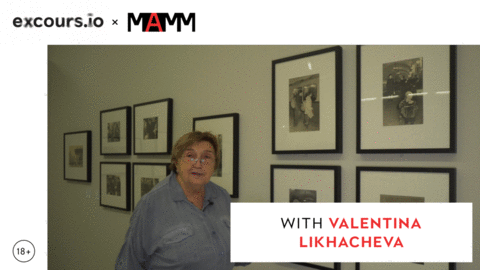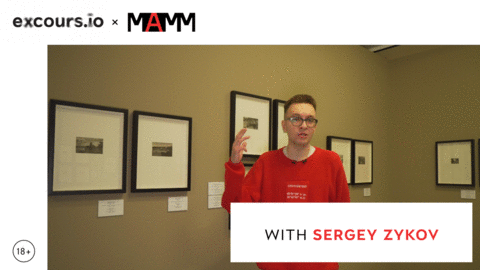Katrin Nenasheva. Between Here and There: Stories of City Isolations
Between Here and There: Stories of Urban Isolation is an exhibition by Katrin Nenasheva that explores the lives of individuals permanently isolated in psychiatric institutions. In her performance, Nenasheva traversed city streets wearing virtual reality glasses displaying panoramic images from these institutions, highlighting the barriers that separate their world from ours. She engaged with the public in various locations, including the subway and Red Square, inviting them to experience her perspective and share the motivations behind her work. The exhibition presents documentation of her journey, allowing visitors to engage with virtual reality themselves, fostering a dialogue between “here” and “there.” This immersive experience encourages reflection on societal isolation and connection.
Why should you watch this?
Katrin Nenasheva’s exhibition Between Here and There: Stories of Urban Isolation offers a profound exploration of the often-overlooked lives of individuals in psychiatric institutions. By donning virtual reality glasses that display panoramic views of these spaces, Nenasheva creates a striking connection between the isolated and the public, inviting visitors to step into her shoes as she navigates familiar urban landscapes. This immersive performance, paired with documentation of her interactions in locations like the subway and Red Square, blurs the lines between separation and engagement. Through this unique experience, attendees are encouraged to confront their perceptions of mental health, societal isolation, and human connection, prompting vital conversations about empathy and understanding in our communities.
Nicholas Roerich. Sanctuaries and Citadels
N.K. Roerich’s exhibition unveils over 80 captivating works inspired by his 1925 Central Asian expedition. With an extraordinary blend of majestic mountain landscapes, Buddhist monasteries, and formidable fortresses, Roerich crafts a compelling narrative of heroism and spiritual pursuit that transcends cultural boundaries. His pieces celebrate the sacredness of labor and the enduring human spirit, evoking a universal call to courage and resilience. Roerich’s unique style, characterized by what can be termed “epic realism,” draws upon his deep understanding of history, folklore, and religious traditions.
Why should you watch this?
N.K. Roerich’s “Shrines and Strongholds” resonates powerfully in today’s world, where themes of resilience, spirituality, and cultural identity are increasingly vital. As modern society redefines spirituality Roerich’s exploration of heroism and the sacred nature of labor offers a poignant reflection on the indomitable human spirit that transcends boundaries of faith and nationality. His majestic depictions of mountain landscapes and spiritual sites serve as symbols of hope, encouraging us to aspire for personal and collective growth. Roerich’s emphasis on courage and the potential for spiritual feats invites contemporary audiences to recognize the shared human experience and the transformative power of art as a catalyst for understanding. The exhibition not only honors Roerich’s legacy but also inspires a renewed dialogue about courage, identity, and our interconnectedness in the global narrative.
Alexander Grinberg. Movement. 1920s
Step back into the vibrant world of the 1920s with the Movement. 1920s exhibition, which captures the revolutionary spirit and artistic innovation of this transformative decade. Celebrating a surge of creativity across visual arts, architecture, and design, the exhibit showcases how artists challenged traditional norms and embraced new mediums and themes. Through a carefully curated selection of works and engaging installations, visitors can explore the interplay between art, politics, and society during a time marked by upheaval and change. From the bold geometries of constructivism to the experimental forms of avant-garde movements, Movement. 1920s invites audiences to witness how the decade laid the groundwork for contemporary art, illuminating the ongoing dialogue between past and present in the ever-evolving landscape of visual culture.
Why should you watch this?
This exhibition features a diverse array of works that reflect the pulse of a society in transformation — bold colors, experimental forms, and a celebration of motion that captures the zeitgeist of post-war optimism. Each piece invites the viewer to engage with the revolutionary ideas that shaped modern art, making it a must-see for anyone interested in the interplay between culture and creativity. It demonstrates how artists of the 1920s broke boundaries and redefined artistic expression, leaving an indelible mark on the contemporary landscape.
Haim Sokol. Testimony
Haim Sokol’s solo exhibition delves into the intricate interplay of memory and oblivion, offering a poignant exploration of individual narratives amidst historical upheaval. Blending documentary material with artistic expression, Sokol showcases a decade’s worth of work that includes videos in collaboration with migrant workers, a workshop dedicated to the art of protest, and a thought-provoking examination of “paper memory.” The exhibition features a rich tapestry of forms — drawings, performances, installations, and objects crafted from diverse materials such as metal, leather, and plastic — all converging around the central video installation “Testimony,” which poignantly recounts his father’s harrowing experiences in a ghetto during WWII. This compelling collection not only honors those marginalized in history but also ignites crucial conversations about identity, resilience, and the significance of personal testimonies in contemporary art.
Why should you watch this?
The guided tour provides a vital lens through which we can confront and reflect on pressing contemporary issues such as migration, displacement, and the struggle for recognition. In an era marked by increasing xenophobia and political polarization, Sokol’s exploration of marginalized voices and historical amnesia resonates deeply, urging us to confront our collective past and present. The guided tour offers insights that enrich our understanding of how memory shapes identity and informs socio-political discourse, making it particularly relevant as today’s world grapples with the consequences of both historical injustices and ongoing humanitarian crises. Engaging with Sokol’s work through a guided narrative not only enhances appreciation for the artistry involved but also emphasizes the urgency of empathy and awareness in combating societal erasure and advocating for the dignity of all individuals.
Human Condition. Session III. “Time And Senses”: Trauma, Memory, Oblivion, Knowledge. Exhibition “The Haunted House”
The Human Condition exhibition, a thought-provoking exploration of contemporary art that delves into the complexities of human experience. This showcase features a diverse collection of works that challenge perceptions and provoke dialogue about identity, society, and the emotional landscape of modern life. Each piece serves as a mirror, reflecting the multifaceted nature of existence in today’s world. Through innovative mediums and striking visuals, the artists invite viewers to engage deeply with themes of vulnerability, connection, and resilience. This exhibition is not just a display of art; it’s an immersive journey that encourages introspection and a deeper understanding of what it means to be human in an ever-evolving society.
Why should you watch this?
А thought-provoking contemporary art exhibition that delves into the intricacies of identity and societal dynamics in our rapidly changing world. This collection brings together diverse artists whose works challenge perceptions and provoke dialogue about what it means to be human today. Through innovative mediums and poignant narratives, the exhibition invites viewers to reflect on personal and collective experiences, making it an essential exploration for anyone interested in the intersections of art, culture, and self. Don’t miss the opportunity to engage with pieces that resonate deeply with our shared humanity, encouraging both introspection and conversation. Experience art that speaks to the heart of contemporary life — your perspective might just change.
“Heart of a Dog” : Adventures of a Banned Book. A Monstrous Story
The exhibition Heart of a Dog: Adventures of a Banned Book. A Monstrous Story delves into the provocative themes of banned literature, spotlighting the cultural ripples caused by censorship. Through a compelling blend of visual art and literary references, this showcase invites visitors to reflect on the power of words and the resilience of artistic expression. By intertwining the narrative of Mikhail Bulgakov’s infamous novella with contemporary artistic interpretations, the exhibition not only celebrates the defiance against oppression but also fosters a dialogue on freedom and creativity in our modern world.
Why should you watch this?
This exhibition boldly confronts the legacy of censorship through Mikhail Bulgakov’s iconic novella. This engaging showcase interweaves contemporary artistic interpretations with the rich narrative of a story that has faced bans and challenges throughout history. Visitors will be invited to reflect on the resilience of creativity and the vital role of free expression in society. By exploring the intersection of literature and visual art, this exhibition not only honors those who defy oppression but also ignites crucial conversations about the boundaries of artistic freedom today.
KOMAR & MELAMID
KOMAR & MELAMID delves into the fusion of art and ideology, spotlighting the pioneering duo known for their satirical takes on Soviet culture. This exhibition showcases their innovative approach to ‘Sots Art,’ a movement that critiques the socialist aesthetic while playfully engaging with the political and commercial landscapes of the 20th century. Through a diverse array of works, including paintings, installations, and conceptual pieces, Komar and Melamid invite viewers to reconsider the purpose and function of art in society. Their collaboration challenges traditional boundaries, marrying humor with profound sociopolitical commentary—a must-see for anyone interested in contemporary art’s dialogue with history and culture.
Why should you watch this?
This exhibition represents the place where art meets incisive commentary on society and culture. This dynamic duo takes you on a journey through the playful yet poignant realm of Sots Art, characterized by a mix of humor and critique. Their works challenges normative ideals and question the role of art under Soviet influence, making it both a historical exploration and a contemporary dialogue. By engaging with their art, you’ll uncover layers of meaning about ideological constructs, consumerism, and identity. It’s a unique opportunity to reflect on how these themes continue to resonate today. Experience firsthand how Komar and Melamid’s innovative spirit invites a critical look at the world around us — ensuring you walk away with new insights and a deeper appreciation for the complexities of art.
Mikhail Grachev. Soviet Daily Life. 1930s—1960s
In Mikhail Grachev. Soviet Daily Life. 1930s—1960s through an array of photographs, artifacts, and multimedia installations, attendees are invited to experience the complexities of everyday existence during a transformative era in Russian history. The exhibition captures the interplay of culture, politics, and personal narratives, reflecting how art and design were interwoven into the fabric of daily routines — from the bustling streets to communal celebrations. By showcasing both the mundane and the extraordinary, the exhibition offers a unique lens on how people lived, worked, and dreamt in a time of significant socio-political change, encouraging visitors to ponder the lasting impact of this period on contemporary society and culture.
Why should you watch this?
Within this exhibition you can immerse yourself in a pivotal chapter of history at this thought-provoking exhibition that brings to life Soviet daily life from the 1930s to the 1960s. Explore a rich collection that reveals the nuances of everyday existence during an era marked by both creative expression and political upheaval. From candid photographs to everyday objects, the showcase highlights the resilience and spirit of individuals navigating a complex social landscape. Beyond mere nostalgia, this exhibition invites you to reflect on how art shaped identity and community, providing timeless lessons on the interplay between personal life and broader societal movements.
Vasily Ulitin. Elegy
Vasily Ulitin. Elegy is a poignant exploration of memory and the human experience, showcasing contemporary artworks that delve into themes of loss and nostalgia. This compelling exhibition brings together a diverse array of artists, each offering a unique lens on the fragility of existence and the echoes of the past. Through striking visuals and thought-provoking installations, visitors are invited to reflect on the transient nature of life and the artifacts of memory that linger in our minds. The careful curation weaves a narrative that transcends individual perspectives, creating a shared space for solace and contemplation.
Why should you watch this?
This exhibition is an emotional journey that invites you to confront the depth of human experience through the lens of contemporary creativity. By showcasing artists who grapple with themes of memory, loss, and the passage of time, this exhibition resonates with anyone reflecting on their own stories. Each piece acts as a portal into personal and collective memories, encouraging introspection and dialogue. The thought-provoking installations challenge you to consider how we hold onto the past and the beauty and pain that intertwine in our lives. Whether you’re an art aficionado or simply curious, this guided tour offers a unique opportunity to engage with profound artistic expressions that linger in the heart and mind long after you leave.

